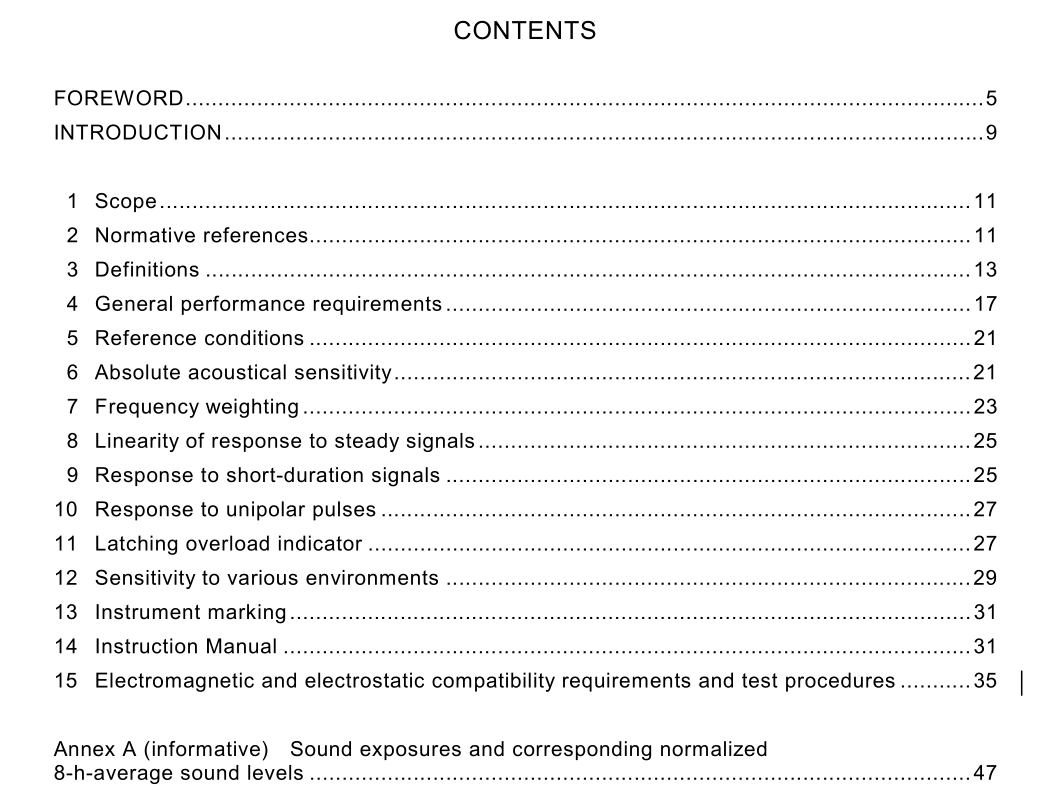IEC 61252 pdf download

IEC 61252 pdf download.Electroacoustics – Specifications for personal sound exposure meters
1 Scope
1.1 Sound exposure is a physical measure that accounts for both the sound pressure and its duration, at a given location, through an integral-over-time of the square of instantaneous frequency-weighted sound pressure. 1.2 This International Standard is applicable to instruments for measurement of A-frequency- weighted sound exposure resulting from steady, intermittent, fluctuating, irregular, or impulsive sounds. Instruments complying with the specifications of this International Standard are intended to be worn on a person to measure sound exposure. Measurements of sound exposure in the workplace may be useful for determinations of occupational noise exposure, in accordance with ISO 1999 and ISO 9612. 1.3 This International Standard specifies acoustical and electrical performance requirements for personal sound exposure meters of one accuracy grade. The accuracy grade corresponds to that for an integrating sound level meter which complies with the Type 2 requirements of IEC 60804 for an A-weighted sound pressure level range from 80 dB to 130 dB and a nominal frequency range from 63 Hz to 8 kHz. 1.4 Tolerances on deviations of an instrument’s performance from specified design goals represent the performance capabilities of practical instruments. Personal sound exposure meters are required to operate within the tolerances of this International Standard over specified ranges of environmental conditions.
3.5 sound exposure range range between an upper and a lower sound exposure, both to be specified by the manu- facturer, within which the requirements of this International Standard are met and which are displayed on the sound exposure indicator 3.6 reference direction direction of sound incidence specified by the manufacturer for determining the absolute acoustical sensitivity and frequency response 3.7 reference frequency frequency of 1 kHz for determining the absolute acoustical sensitivity 3.8 reference sound pressure level sound pressure level specified by the manufacturer for determining the absolute acoustical sensitivity 3.9 reference integration time integration time specified by the manufacturer for determining the absolute acoustical sensitivity 3.10 reference sound exposure calculated sound exposure corresponding to the reference sound pressure level, at the reference frequency, applied for the reference integration time The following definition applies in addition to those specified in IEC 61000-4-2, IEC 61000-4-3, IEC 61000-6-1, IEC 61000-6-2, and CISPR 61000-6-3. 3.11 reference orientation (of a personal sound exposure meter) orientation of a personal sound exposure meter that corresponds to the meter as worn in normal use by a person standing upright and facing the principal direction of an emitter or receiver of radio-frequency electromagnetic fields
4 General performance requirements
4.1 A personal sound exposure meter is a combination of a microphone, an amplifier with the required A-frequency weighting, a device to square the frequency-weighted sound pressure signal, an integrator over time, an indicator of sound exposure, and a latching overload indicator. Sound exposures that have been accumulated during a measurement period are retained in the memory until the instrument is reset and are not deleted by triggering of the latching overload indicator.4.2 Because only its overall performance is important, an actual instrument need not be separable into individual functional elements. However, for convenient description of required characteristics, the instrument is considered as if it were a combination of the separate elements shown in figure 1. 4.3 The manufacturer shall provide the means to substitute an electrical input signal in place of the microphone, for the purpose of performing tests on the complete instrument without the microphone. NOTE The manufacturer may provide an accessible input test point or recommend and provide a dummy microphone or equivalent input adapter (electrical or non-electrical) for performing electrical tests on the instrument. 4.4 An optional (but preferred) accessible output test point may be provided. 4.5 The sound exposure indicator may be built into, or be separate from, the wearable part of an instrument. The quantity indicated is sound exposure, either as a direct indication or as a fraction or percentage of a manufacturer-specified sound exposure. If sound exposure is not indicated directly in pascal-squared hours (Pa 2 h), the manufacturer shall provide suitable means to convert the indication to sound exposure in pascal-squared hours. 4.6 The smallest increment of sound exposure displayed by the indicator shall be not greater than 0,1 Pa 2 h. The sound exposure range shall be at least from 0,1 Pa 2 h to 99,9 Pa 2 h.









